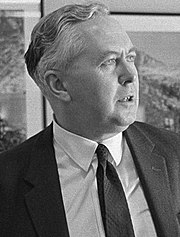Harold Wilson's Human Design Chart
4/6 Emotional Projector**Harold Wilson** (March 11, 1916 – May 24, 1995) was a prominent British politician and a two-time Prime Minister, serving from 1964 to 1970 and again from 1974 to 1976. Born in Huddersfield, England, Wilson’s early academic pursuits included teaching economics at Oxford, where he graduated in 1937 and became a fellow of University College in 1938. His career in politics began when he was elected to Parliament as a Labour member in 1945, making him the youngest cabinet member in 20th-century British politics.
As a Projector in Human Design, Wilson’s strategy was to “Wait for the Invitation,” a reflection of his ability to guide and influence others through his insights and wisdom. This aligns with his role in the Labour Party, where he became a leading voice for the left-wing faction, advocating for policies such as unilateral nuclear disarmament. His emotional inner authority allowed him to navigate the complexities of political leadership, making decisions that resonated with the collective sentiment of his party and the nation.
Wilson’s leadership journey began in earnest after the death of party leader Hugh Gaitskell in 1963, when he won the Labour Party leadership and subsequently became Prime Minister in 1964. His tenure saw significant social and economic reforms, although the Labour Party faced defeat in the 1970 elections. However, Wilson’s resilience shone through as he regained power in February 1974, leading the country until his unexpected resignation in March 1976.
In Human Design, Wilson’s Profile of 4/6 indicates a natural role as a networker and role model, blending personal connections with a deeper understanding of societal structures. His Incarnation Cross, the Right Angle Cross of Rulership (22/47 | 26/45), suggests a life path centered around leadership and governance, where he was destined to influence the direction of his country.
Beyond his political career, Wilson was also a prolific writer, with notable works including “A Personal Record” (1971), “Final Term: the Labour Government 1974-1976” (1979), and “Memoirs” (1986). He was knighted in 1976 and became a life peer in 1983. Wilson’s family life included his wife, Mary, and their two sons, Robin, a mathematics lecturer at Oxford, and Giles, a schoolteacher.
After a prolonged battle with Alzheimer’s Disease, Harold Wilson passed away on May 24, 1995, in London, leaving behind a legacy marked by his contributions to British politics and his unique perspective as a Projector in the realm of Human Design.
Discover More Famous People
Browse and analyze over 55,000 public figures and celebrities.
Ra Uru Hu
5/1 Manifestor
Martha Stewart
4/6 Manifestor
David Lynch
4/6 Generator
Barack Obama
6/2 Projector
Steve Jobs
6/3 Generator
Vladimir Putin
5/1 Manifestor
Kim Kardashian
3/5 Generator
Michael Jackson
1/3 Projector
Marilyn Monroe
6/2 Projector
Ariana Grande
2/4 Projector
Oprah Winfrey
2/4 Generator
Johnny Depp
2/4 ManifestorWhat is HumanDesign.ai and how does it work?
Curious what makes Harold Wilson tick? HumanDesign.ai instantly maps their exact birth data into a fully interactive clickable bodygraph chart, letting you hover or tap every center, channel, and gate for plain-language explanations. Bella, the platform’s built-in AI guide, adds context in real time, translating complex mechanics into everyday insights so you can see how Harold Wilson’s strengths, challenges, and life themes play out on-screen.
The same tools are waiting for you. Generate your own Human Design Chart in seconds, open a library of 2000+ suggested questions, and chat with Bella as often as you like to decode your design, daily transits, and even relationship dynamics.
Want to compare energies? Save unlimited charts for friends, family, or clients, then ask Bella to reveal compatibilities, composite patterns, or coaching tips, all in one conversation thread.
Start free with core features, or unlock our Personal and Pro plans for deeper dives: unlimited Q&A, celebrity chart search spanning 55,000+ public figures, white-label PDF reports, branded content generation, and a professional profile with built-in booking for practitioners. Whether you’re exploring your own potential or guiding others, HumanDesign.ai delivers an ever-expanding toolbox of AI-powered insights—no spreadsheets, no jargon, just clarity at your fingertips.
Ready to see yours? Signup for FREE today!

